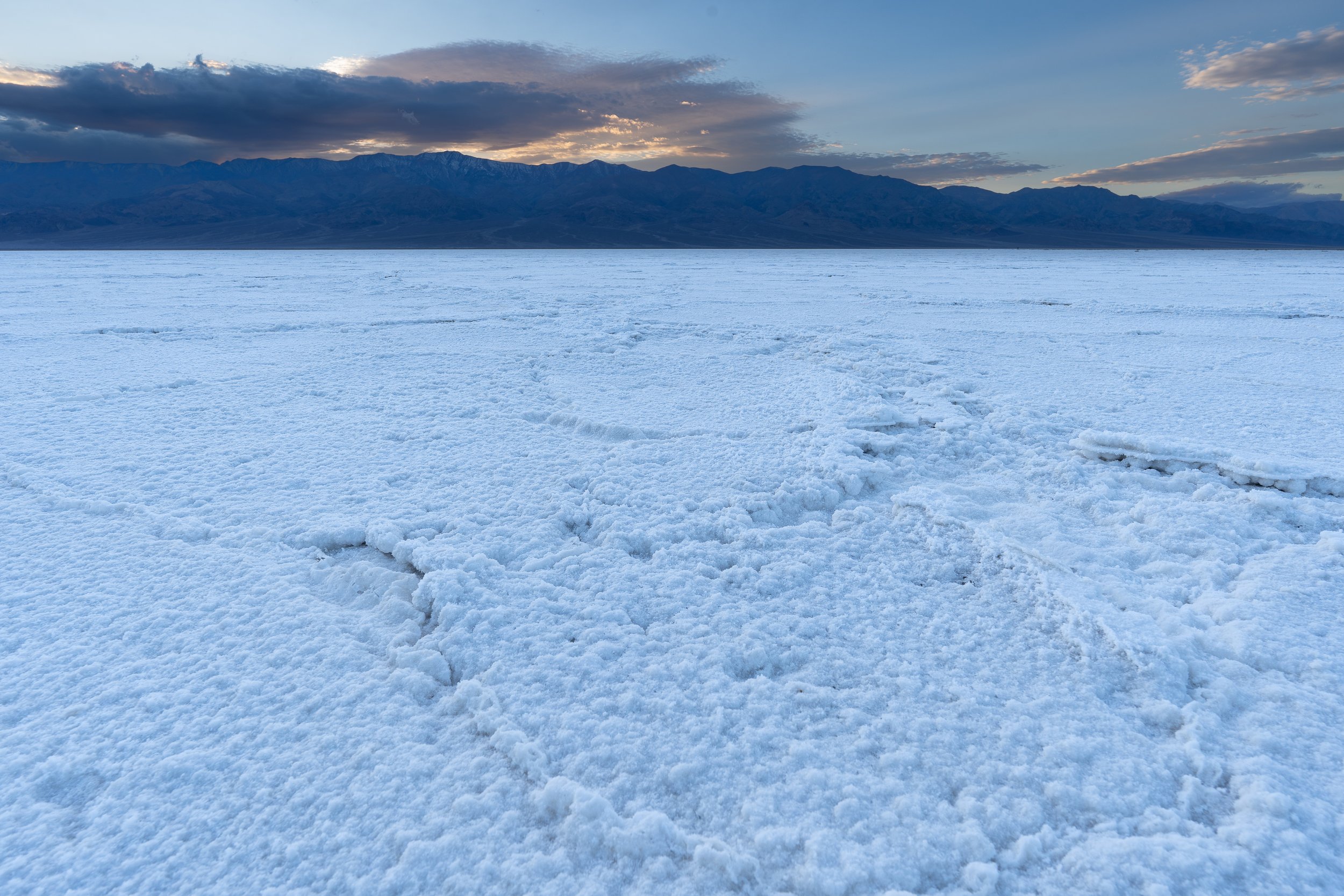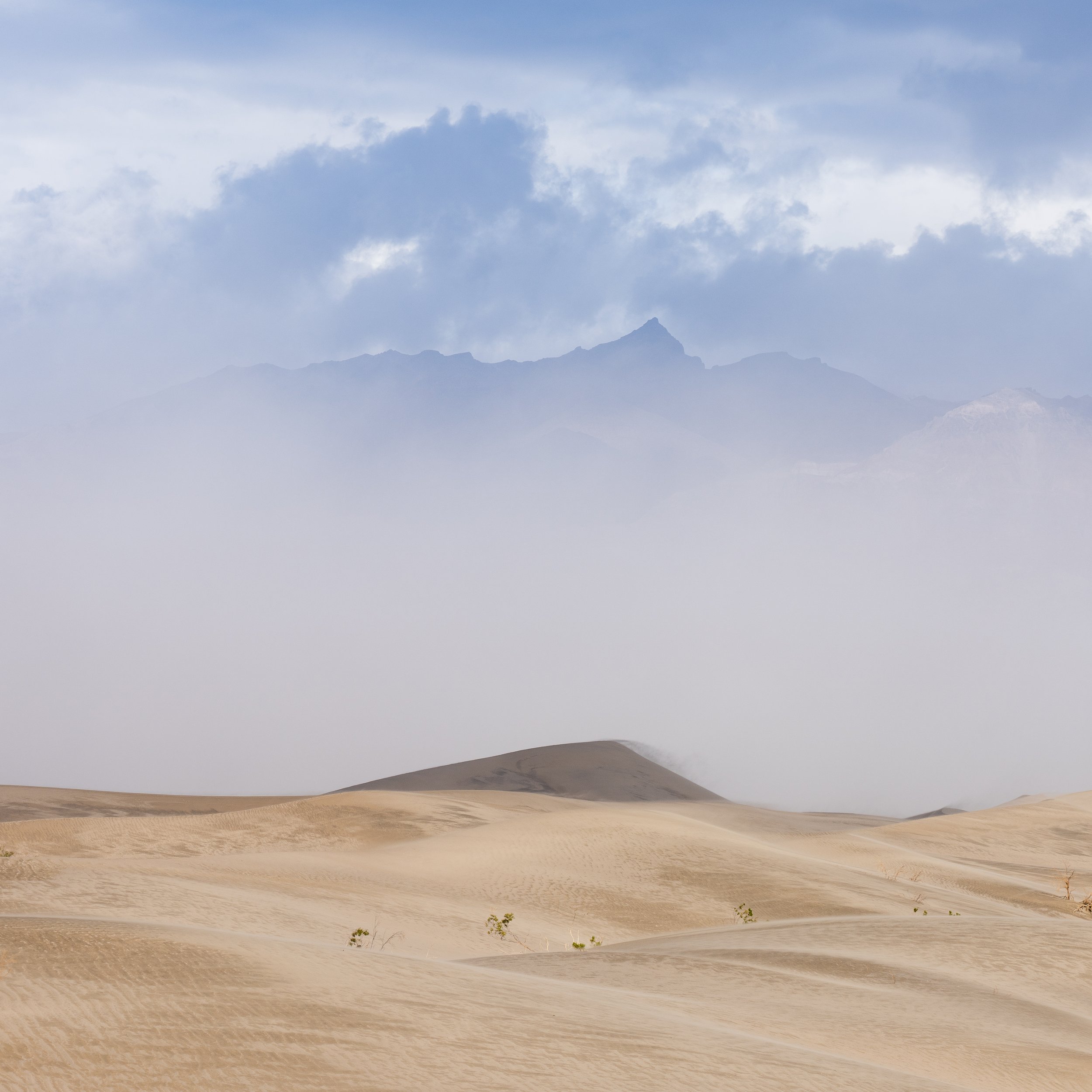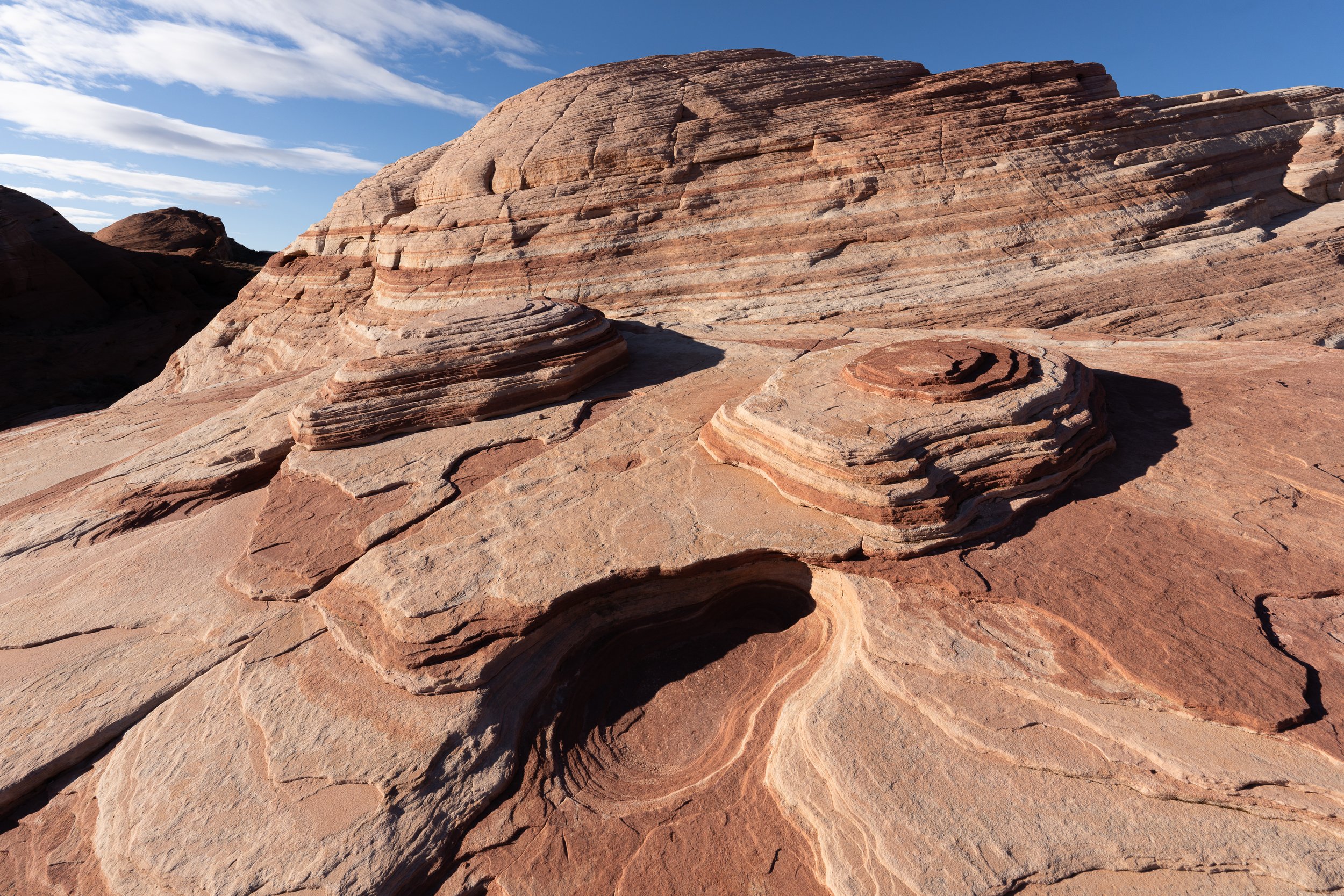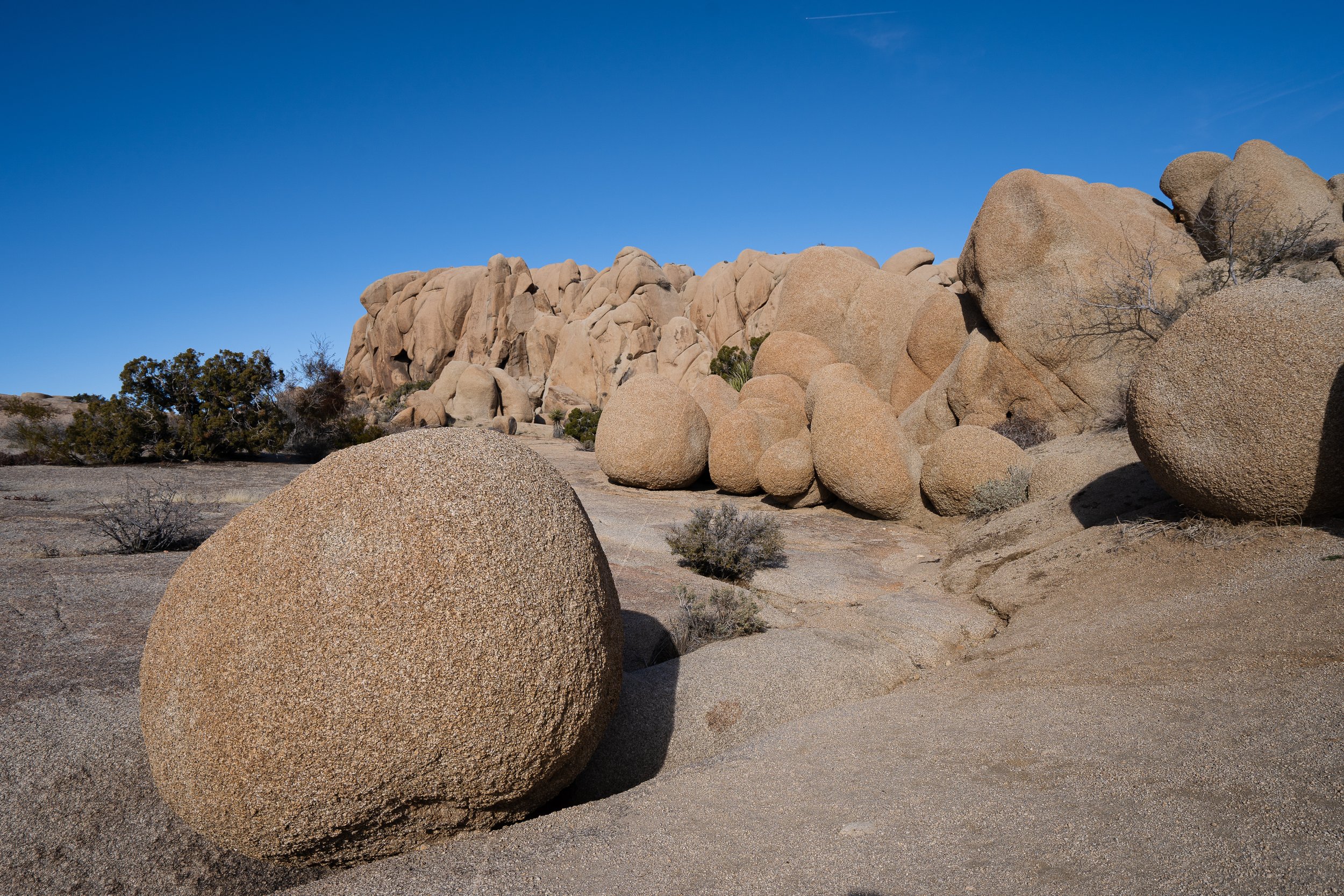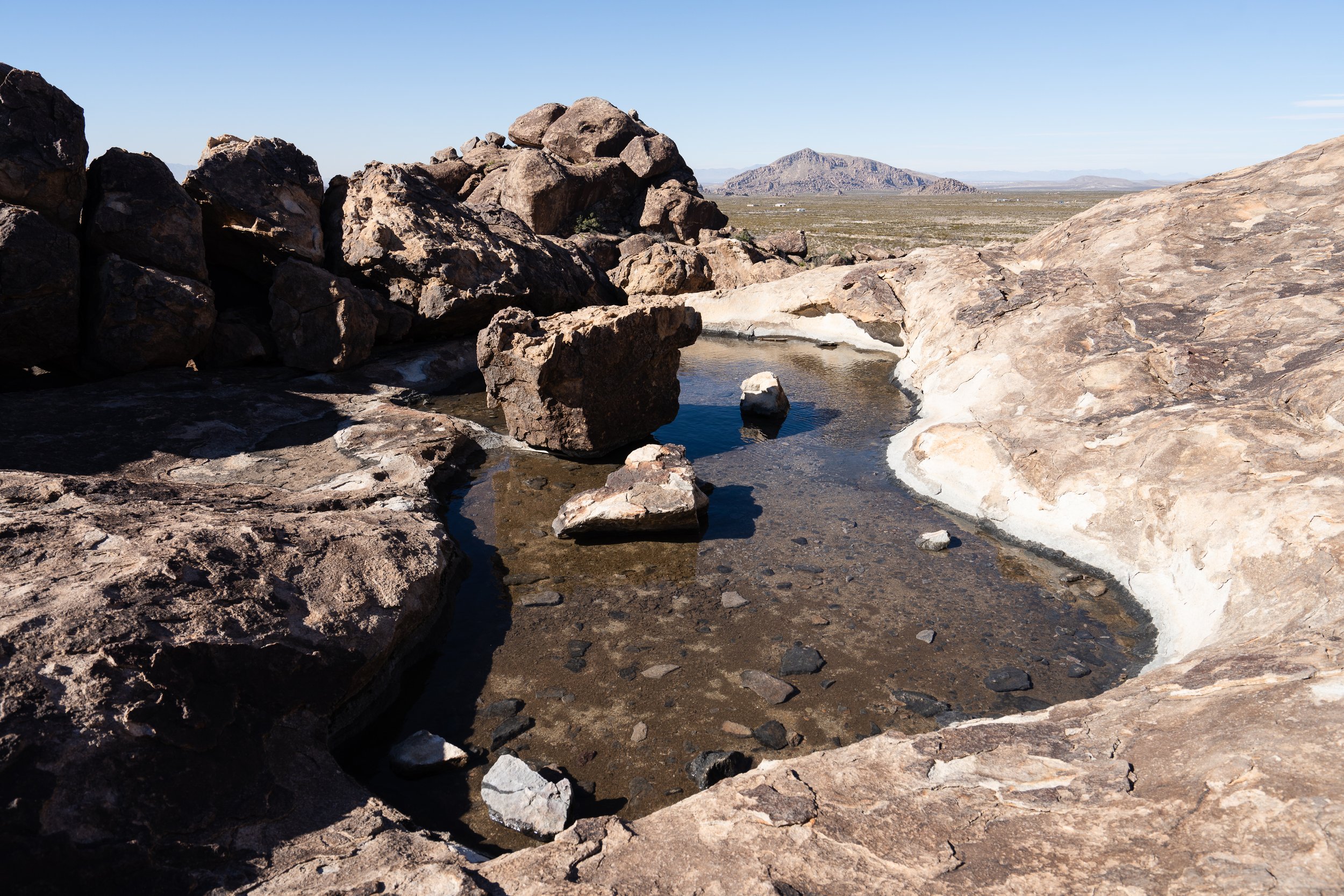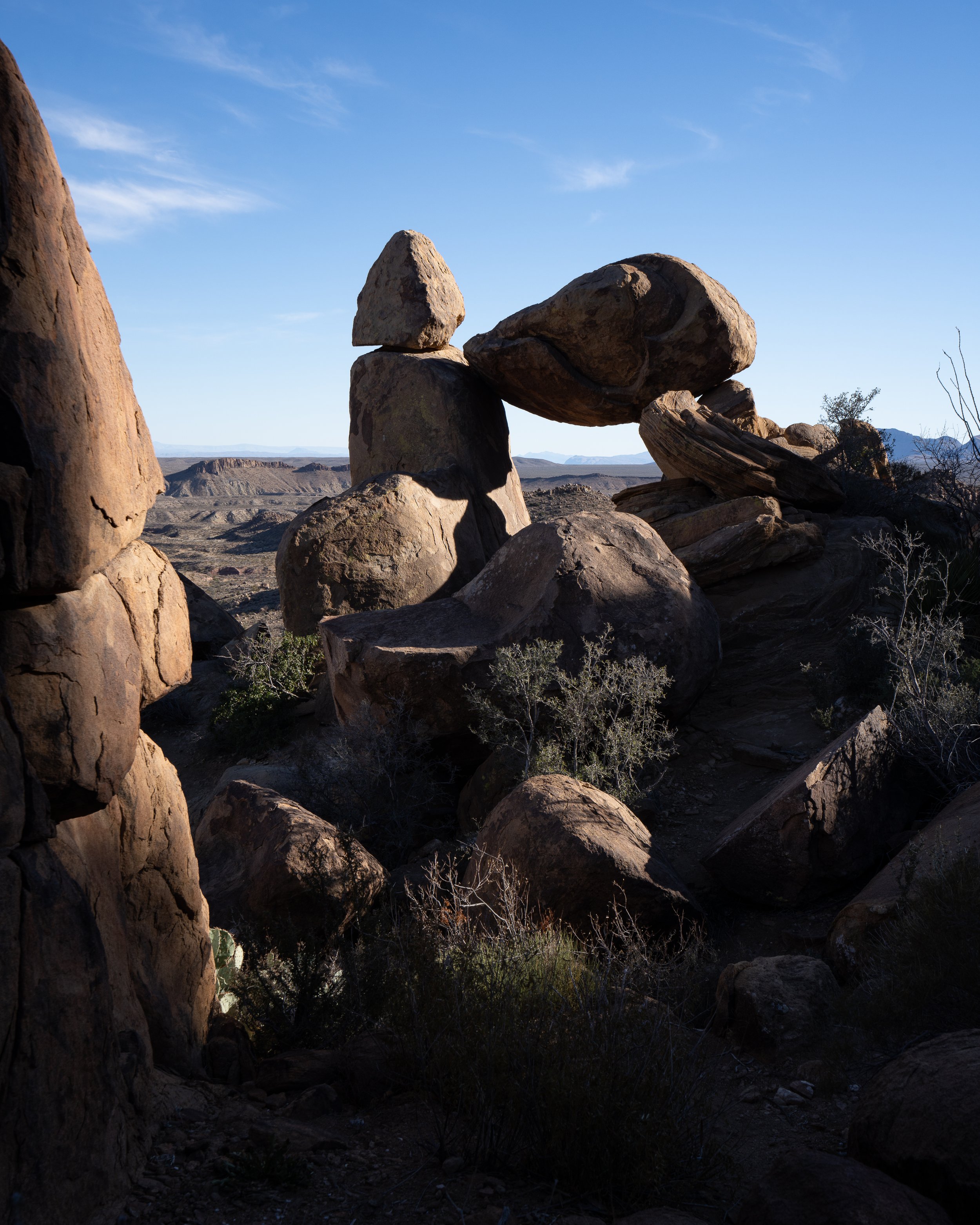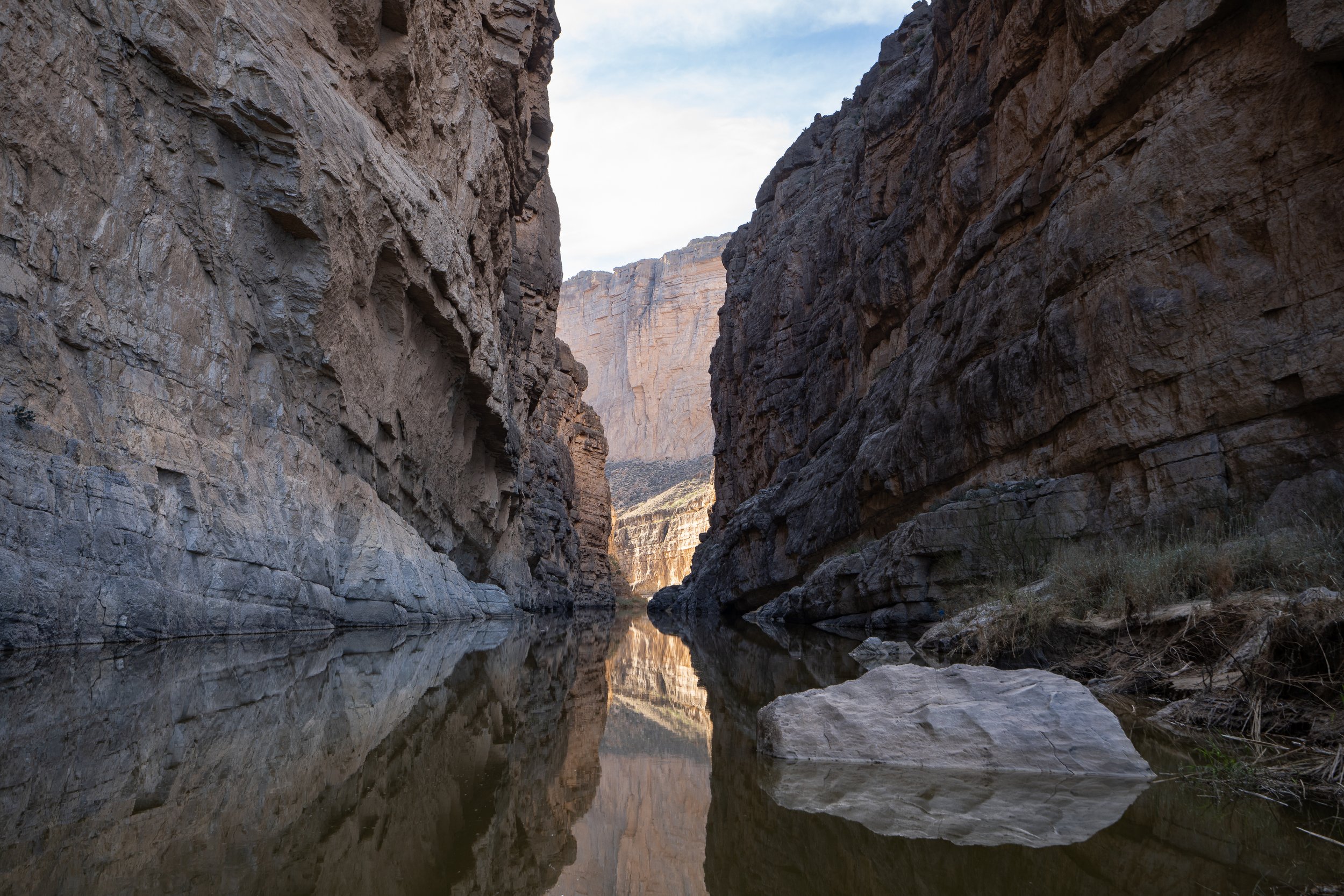When it is time to run from the cold and rain, the desert states seem like the perfect place to get back to sunshine and that dry heat. That was the plan and for the most part we found a good amount of sun but for some odd reason the cold was still following us down from the north. We left the coast after visiting friends near San Jose and travelled up to Lake Isabella. It was a fantastic road up through Sequoia National Forest and our first night of BLM camping along the Kern river.
The view from our campsite on the Kern River. Sony A7III with 16-35 f/4 at 19mm, f/9, 1/800s ISO 1600
This is definitely an area we would like to come back and explore again as there were old mines fantastic rock formations and signs of animals in the area. This trip however we just spent the one night and headed towards Death Valley. This seemed like a great idea as it almost never rains there, right?
Well, we were lucky enough to come in just before a huge wind and rainstorm that tested the strength of our camper (and our sanity). It wasn’t all bad, in fact the weather actually made for some pretty spectacular photography. Scenes that were probably pretty rare with storm clouds on one side of the valley and sun on the other.
Salwa was finding sand in her hair for days after this hike. Sony A7RIV with 24-105 f/4 at 46mm, f/9, 1/400s, ISO 100
The salt flats is the first spot we went to see what sunset would be like. The views were amazing, the salt flats such a cool thing to see but that evening the light wasn’t fantastic. We did get a few interesting shots but went away that night without a portfolio shot.
Salt flats at sunset, not quite the sunset we hoped for but still such an amazing place to explore. Sony A7III with 16-35 f/4 at 19mm, f/10, 1/20s, ISO 100
The next day was a different story. The wind picked up again and we could see storm clouds around us so we drove north again towards the sand dunes which looked promising. We managed to get out about a half mile into the dunes when the wind suddenly went crazy, blasting sand at us and then the sky opened up pelting us with rain that felt like pellets from an air gun. This didn’t stop us completely as we tried to get some video of the situation, mostly so that we could laugh at ourselves. We got back to the truck and the rain moved away after about 10 minutes. This was when the sky started to look wild. Dark clouds and rain in front of us with harsh sunlight on the dunes and the wind still throwing the sand around. I think I have at least 10 shots that I could print from the next hour out there…maybe more.
A rain storm making its way past us across the valley of Sand dunes. Sony A7RIV with 24-105 at 105mm, f/10, 1/250s, ISO 100
The sand was still blowing in the distance, but the light and shadows were amazing as the storm clouds moved on. Sony A7RIV with 24-105 at 43mm, f/9, 1/320s, ISO 100
Salwa on the top edge of one of the larger sand dunes. Sony A7III with 16-35 f/4 at 34mm, f/9, 1/320s, ISO 100
As per usual on this trip the weather was starting to turn again as we heard that snow was coming for the mountains on the way to Vegas. We decided to run for the hills, and got to the very top just in time for the snow. It was a slow and nervous trip down into Las Vegas that night but after a night at a KOA campground to get a shower, wash some clothes and get the batteries topped up we were headed to a park on the other side of Vegas called Valley of Fire.
Salwa near the beginning of wave of fire hike. Sony A7III with 70-200 f/4 at 70mm, f/4, 1/1000s, ISO 100
This turned out to be one of the best stops of the entire trip, and I had barely heard of the place before we went there. We camped at the Atlatl Rock campground in the park where we were surrounded by fantastic red rocks with desert bighorn sheep wandering through regularly. Just hiking through these rocks could take up your time for days.
Waves of weathered rock. Sony A7RIV with 16-35 f/4 at 17mm, f/11, 1/200s, ISO 100
We spent most of our time hiking along White Domes road with beautiful slot canyons that we accessed from the end of the road.
Part of the Slot canyon near White Dome. Sony A7III with 16-35 f/4 at 16mm, f/10, 1/20s, ISO 100
From just after the sun came up we wandered all around Fire Wave trail. This area had some of the most spectator rock formations and wild colors. This is an area to check out with a quick hike and then come back again and again in different light. I think I would like to come back here and spend at least a week capturing dawn and sunset shots. If you are into astro or night sky photography you might find you will really never have time to sleep in this park.
So many textures and colours make the Wave of Fire hike a photographers dream. Sony A7RIV with 16-35 f/4 at 16mm, f/11, 1/125s, ISO 100
Pink, orange, red…pick your favourite colour. Sony A7III, 16-35 f/4 at 16mm, f/8, 1/100s, ISO 100
When we finally did leave Valley of Fire we were off to another very different desert landscape. This was an area we visited years ago in a 1976 VW Westfalia. Joshua tree may not have the same wild colors but the shapes of the boulders, and the Joshua trees themselves make for some wild landscapes.
If you can’t find camping in the park, there is an area at the south end of the park for BLM camping which will allow you to spend your days in the park without too much time on the road. On this trip we spent most of our time around Jumbo Rocks and Cottonwood.
A dead tree with some fantastic boulders in the background. Sony A7RIV with 24-105 f/4 at 34mm, f/8, 1/80s, ISO 100
I see a face, do you? Sony A7RIV with 24-105 f/4 at 49mm, f/9, 1/320s, ISO 100
a boulder playground. Sony A7III with 16-35 f/4 at 22mm, f/7.1, 1/800s, ISO 100
Joshua tree hugging Salwa…always another tree to hug. Sony A7III with 16-35 f/4 at 26mm, f/9, 1/250s, ISO 100
hiking near Cottonwood campground. Sony A7RIV with 24-105mm at 31mm, f/13, 1/25s, ISO 100
Night sky and a Joshua tree. Sony A7III with 16-35 f/4 at 16mm, f/4, 25s, ISO 1600
At this point we started to put California, and Nevada into our rear view mirror and headed to Arizona. Organ Pipe Cactus National monument was going to be our first stop and was one of the first times we actually had some warm weather (at least for a couple of days). This park is a little south west of Phoenix down on the Mexican border and it is easy to see what this park is named for.
Sunset in Organ Pipe Cactus National Monument. Sony A7III with 70-200 f/4 at 200mm, f/5.6, 1/1000s ISO 1600
This is also when we started seeing more birds and I was able to pull out the big lens.
Cactus Wren. Sony A7III with 200-600 f/5.6-6.3 at 600mm, f/6.3, 1/1250s, ISO 250
Phainopepla. Sony A7RIV with 200-600 f/5.6-6.3 at 600mm, f/6.3, 1/2000s, ISO 250
Mexican Scrub Jay. Sony A7RIV with 200-600 f/5.6-6.3 at 600mm, f/6.3, 1/2000s, ISO 200
Again, just outside of this park is some BLM land for camping, we stayed in the park this time and learned quickly that there is an area that is generator free so that you don’t have to listen to loud engines instead of the nature in the park.
I have parents that were snowbirds for around 20 years and spent a good deal of their winters in Tucson so I have in the past been able to come down and spend time in that area. Tucson Mountain state park is a great area to get into some of the desert hiking and to wander amongst the Saguaro cactus that so much reminds me of Saturday mornings watching the bugs bunny/road runner hour.
Saguaro cactii and the view into Tucson Mountains state park. Sony A7III with 24-105 f/4 at 24mm, f/8, 1/320s, ISO 100
This time around we spent only a couple of nights in this area but also went up to Mount Lemmon to check out some wildly different terrain and to give us some time for some good food in Tucson itself.
multiple hoodoos to hike through and around. Sony A7III with 24-105 f/4 at 24mm, f/10, 1/160s, ISO 100, 6 shot panorama
More interesting rock formations along the road up Mt. Lemmon. Sony A7III with 24-105 f/4 at 34mm, f/10, 1/320s, ISO 100
On the next portion of the trip we went to a bunch of areas we found out about through other campers, as we headed east just before the New Mexico border there is a small town called Portal which is just that, a little portal into another amazing piece of landscape and also another little birders haven. The whole area from Madera Canyon to Patagonia Lake and across to Portal are great locations to find hummingbirds and many birds that are only found in Arizona and Mexico.
Anna’s hummingbird near Patagonia Lake, Arizona. Sony A7RIV with 200-600 f/5.6-6.3 at 600mm, f/6.3, 1/2000s, ISO 1000
Blue throated hummingbird. Sony A7RIV with 200-600 f/5.6-6.3 at 600mm, f/6.3, 1/800s, ISO 8000
broad billed hummingbird. Sony A7RIV with 200-600 f/5.6-6.3 at 600mm, f/6.3, 1/2000s, ISO 500
Since moving into Arizona we had been lucky enough to have much more sunny weather even if not nearly as warm as we would have liked. This continued as we worked our way into New Mexico and White Sands national park but our hopes to head into northern portions of New Mexico were not going to be on this trip as ice and snow were in the forecast for Albuquerque and Santa Fe.
The shadows bring out the textures in these nearly monochromatic images. Sony A7RIV with 24-105 f/4 at 24mm, f/11, 1/320s, ISO 100
The wind shapes the land. Sony A7RIV with 24-105 f/4 at 52mm, f/11, 1/250s, ISO 100
Black and white image of the rolling dunes. Sony A7RIV with 24-105 f/4 at 89mm, f/11, 1/400s, ISO 100
This meant a whole new plan was in order and now Texas looked to be one of the few areas that was going to be warm enough for us to camp. On the map was Big Bend Nation Park and as with anything in Texas it was a fairly long drive. Our first stop on this leg was Hueco Tanks, a park I had always wanted to visit when I was a younger and was fairly active in bouldering and climbing. This park is a haven for bouldering and we watched a few climbers attempting stuff I couldn’t think of now.
An example of the defining feature here in Hueco Tanks. Sony A7RIV with 16-35 f/4 at 22mm, f/14, 1/80s, ISO 100
Hueco tanks is a very protected area with some significant native historical landmarks and petroglyphs so treading carefully and only in the self-guided parts is important to ensure others will be able to enjoy this area for years to come.
Some fantastic petroglyphs in a cave. We had to be so careful not to touch the wall in this tight and slippery location. Sony A7RIV with 16-35 f/4 at 16mm, f/4, 1/8s, ISO 1600
Just the view from in the cave, but the light was so amazing this is one of my favourite shots from the trip. Sony A7RIV with 16-35 f/4 at 16mm, f/9, 4s, ISO 100
Getting a bit closer to Big Bend, we found a nice park to stay at in Fort Davis which has a big Observatory near by. Nice hiking, camping and dark skies along with some more desert bighorn sheep made for a good stopover before some outback camping on the north end of Big Bend. We didn’t get a chance to check out the observatory this time, but I definitely would like to come back just for that.
Sunset from the lookout at Davis Mountain. Sony A7III with 24-105 f/4 at 105mm, f/22, 1/15s, ISO 640
Our first night in Big Bend was at a spot called Nine Point Draw and we were out there completely on our own. This was so beautiful and quiet. We were able to really relax and just enjoy the scenery. I think we could have spent weeks in the National Park and the state park combined. We managed a number of interesting hikes, one called balancing rock (how many of those are there?) was very picturesque, the hike down to what was called the window to the world was busy but still worth it. Finally the view into Santa Elena Canyon was amazing.
Balancing rock, Big Bend National Park. Sony A7RIV with 16-35 f/4 at 35mm, f/10, 1/125s, ISO 100
Window to the world. Sony A7RIV with 16-35 f/4 at 16mm, f/10, 1/40s, ISO 100
Santa Elena Canyon. Sony A7RIV with 16-35 f/4 at 35mm, f/8, 1/50s, ISO 100
At this point in out trip things took a turn…we didn’t know if we should head back west and try to find warm weather in southern Arizona and California or to continue east since we were interested in a boat show in Miami in a couple of weeks. Our indecision was also challenged as we found a problem with our trailer that caused us to spend a week in San Antonio to get fixed (thank you Arkto for dealing with this so well for us). Our decision was made for us as the weather became ice and snow all the way to San Antonio and we managed to miss the worst of it by heading straight towards Louisiana and onwards to the east coast, but that’s a story for the next posting.
This was a fun road through Big Bend State Park. Sony A7III with 200-600 f/5.6-6.3 at 200mm, f/7.1, 1/2000s, ISO 2000



